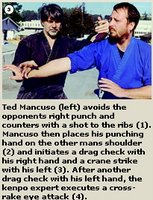 Very good Kenpo article on checking by Ted Mancuso.
Very good Kenpo article on checking by Ted Mancuso.Key points:
"...checking is the countering of a movement before it becomes an identifiable strike. In other words, a check stops an assailant before he can even start his attack."
"Don't withdraw your non-punching hand. Keep it in position to check your opponents arm as you strike back. You may sacrifice the extra power of the withdrawal, but thats a small price to pay for not being hit."
The following are four of the most effective ways kenpo teaches students to execute a checking-hands maneuver:
Active Check: It involves simply laying your checking hand over your opponents limb. For instance, he throws a right punch, and you block it while checking his left punch which he had probably planned as his next attack with your right hand. You can then simultaneously deliver a left strike to his face.
Position Check: The opponent throws a right punch, and you block it on the inside using your right hand. You simultaneously raise your left hand into a cover hand that is positioned near your right shoulder. If he attempts to throw a high left punch, your check can intercept it and allow yourself a bit of time to duck. If he attempts a low left shot to your ribs, your right (anchored) elbow is already in position to close that line of approach.
Drag or Friction Check: Dont misinterpret checks as just frozen hand motions, for they can be very lively. For instance, you toss a right hand at your opponent, and he blocks it with his left hand. Before he even thinks about it, you wipe down the length of his arm while driving forward with a left palm strike. You have used the friction check to prevent his strike and aid your counter.
Pinning Check: Your opponent grabs your lapels with both hands. Rather than
try to disengage from him, you cover and pin his arms with your left hand while you strike his solar plexus. The pinning check ensures that his limbs stay where they are, at least for a while, and it can be a perfect lead-in for a follow-up technique.
Mike and I were working on this the other day. I'd like to learn more, but this is a very effective tactic for me.

No comments:
Post a Comment